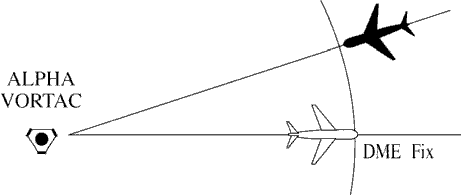6-4-3. MINIMA ON OPPOSITE COURSES
- Views Views: 923
- Last updated Last updated:
-
6-4-3. MINIMA ON OPPOSITE COURSES
Separate aircraft traveling opposite courses by assigning different altitudes consistent with the approved vertical separation from 10 minutes before, until 10 minutes after they are estimated to pass. Vertical separation may be discontinued after one of the following conditions is met: (See FIG 6-4-19.)
FIG 6-4-19 Minima for Opposite Courses Separation 
NOTE: RNAV route segments that have been expanded in the proximity to reference facilities for slant-range effect are not to be considered “expanded” for purposes of applying separation criteria in this paragraph.
- Both aircraft have reported passing NAVAIDs, DME fixes, or waypoints indicating they have passed each other.
(See FIG 6-4-20.)
FIG 6-4-20 Minima for Opposite Courses Separation 
NOTE: It is not intended to limit application of this procedure only to aircraft operating in opposite directions along the same airway or radial. This procedure may also be applied to aircraft established on diverging airways or radials of the same NAVAID.
- Both aircraft have reported passing the same intersection/waypoint and they are at least 3 minutes apart.
- Two RNAV aircraft have reported passing the same position and are at least 8 miles apart if operating along a route that is 8 miles or less in width; or 18 miles apart if operating along any route segment that is greater than 8 miles in width; except that 30 miles must be applied if operating along that portion of any route segment defined by a navigation station requiring extended usable distance limitations beyond 130 miles.
- An aircraft utilizing RNAV and an aircraft utilizing VOR have reported passing the same position and the RNAV
aircraft is at least 4 miles beyond the reported position when operating along a route that is 8 miles or less in
width; 9 miles beyond the point when operating along any route segment that is greater than 8 miles in width;
except that 15 miles must be applied if operating along that portion of any route segment defined by a navigation
station requiring extended usable distance limitation beyond 130 miles; or 3 minutes apart whichever is greater.
NOTE: Except for GNSS-equipped aircraft /G, /L, /S, and /V, not on a random impromptu route, paragraph 5-5-1, Application, requires radar separation be provided to RNAV aircraft operating at and below FL450 on Q routes or random RNAV routes, excluding oceanic airspace.
- Both aircraft have reported passing NAVAIDs, DME fixes, or waypoints indicating they have passed each other.
(See FIG 6-4-20.)